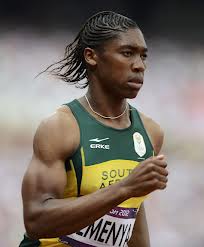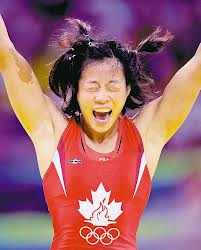The media today is full of messages of masculinity and femininity but what we do not realize is how much of these messages are present in our lives. The media is a very influential mechanism, which people spend around 4 and a half hours paying attention to (Aulette 397). There are two types of images that are prominent in the media, these images are of hegemonic masculinity: “ the subordination of women, authority, aggression and technical competence”, and emphasized femininity: “ includes dependence, sexual receptivity, motherhood and subordination of men” (Aulette 397). These images can be seen all over our world whether it is in the world of sports, music and movies, the stigmas of men and women are problematic and need to be critically analyzed.
Sports:
In the world of sports, there are stigmas of the sports men and women should play, which usually relates to stereotypical views of what men and women are able to do. Men are seen as being able to perform and excel in physical sports because of their strength, meanwhile women are seen as more fragile and should perform in less physical sports so that they do not get hurt. I have heard so many times that women should be doing something else other than playing sports or that girls do not play sports. This is problematic because phrases like these create stereotypes and makes it hard for women who do feel sports to feel feminine while playing them.
I had a bad experience when I first tried out for a body contact boys hockey team. I was laughed at and told by multiple people that I would never make it because I was a girl and girls do not play sports. This experience was the first time I felt like I was not good enough to do something because of my gender. At the tryouts, I had body checked some of the best players and made them fall and I was scoring tons of goals but at the end of the tryout I was cut from the team. I was devastated because I was better than a lot of boys; I decided to take the decision to a hearing at the district because I had all the skills to be on the team. At the hearing, I was told that I did not make the team because I was a girl and girls cannot handle playing on a boy’s hockey team. The experience of not making a team because I was a girl made me think that I should be doing more feminine things and that I should look more feminine because I was playing a sport that was deemed masculine. I started trying to dress girlier with lace and pink and I wore more make up than I usually did. I felt like although my gender had hindered me a spot on the team, I still had to prove my femininity on a team filled with boys. This made me question: why it was so important to prove my femininity because I played a sport usually boys play, is girls playing sports really that big of a deal?
As fluffykitty123 has stated many women face the same challenge I did with trying to prove their femininity to not only themselves but to the world. This is problematic because they have accomplished so much and yet their accomplishments are nothing compared to their gender and their appearance. Carol Huynh is a freestyle wrestler, who won a gold medal in the Olympics but when taking pictures she had to stand very feminine and in wore clothing that expressed her gender and femininity.
This is Carol Huynh when she is wrestling, her strength radiates from the picture and she should be credited as much as an male wrestler who won a Gold Medal for the Olympics yet she is still shown in other picture as fragile and feminine.
This is Carol Huynh, showing off her Gold Medal from the Olympics and dressed in a very feminine and traditional Chinese dress. Her gender has to be shown to the world more than her medal because of the stigma of women in the sports world.
This makes me wonder: Are men the only people who are able to excel in sports or is there room for women to be accepted and praised for their accomplishments too?
Music:
The music industry today is one of the biggest industries that teenagers, children and adults pay attention to. The use of this type of media to portray specific images of gender and race reach a wide variety of people.
Within the music vides performed by men, women are always in skimpy clothing and they are seen as objects to satisfy the male performers. The women are usually dancing in a sexual way and used as objects of pleasure for the males in the videos. For example, the video displayed below is “Rack City” by Tyga, while watching the video pay attention to the use of women as sexual objects, how they are dressed in the skimpiest of clothing and how their faces are almost never present. The songs lyrics are also about a woman’s chest and strippers, which is degrading to women because there is more to women than just their body parts.
http://www.youtube.com/watch?v=oMe27a4gGaw
In female music videos the women are usually trying to use their sex appeal to sell their song; they dance, look and appeal to be sexy, which makes women who sing to send a message less appealing to entertain us. It also send the message that being sexy will get you the attention you want from men when the attention women really need is love and passion. For example, Christina Aguilera’s video “ Dirty” is a very sexual video. In the video she is half – dressed and is dancing in a very sexual way using her body to attract attention. The song lyrics are also about being dirty, sexual and a party animal, this lands her the attention of the men in the room. This is problematic because young girls attempt to imitate her and dance like her hoping to receive attention from men.
http://www.youtube.com/watch?v=A-O7zlrpIBo
Music videos also display a certain stigma of races because in many music videos, people with darker skin are portrayed in a negative way. They are seen as thugs, gangsters, trouble- makers and law-breakers, there are also a lot of videos, which show men of darker skin as drug users or dealers. These images are damaging because people begin to believe that all people of colour represent these stereotypical views.
http://www.youtube.com/watch?v=lVu7WFcS8UQ
In the above video, “ Bad Bitches & Good Weed” by Young lace is one video that shows the lifestyle of a black person who smokes and sells weed. This video is just one of the many videos that generalize people of colour. This is problematic because many people begin to believe that what is posted in the media is the truth, which leads people to believe that all people of colour are represented by the people on television and in music videos.
This leads me to question the messages we are receiving from the music videos. Is the media really the driving force for what makes us who we are because it is displayed on television or in music videos? For women, is being displayed as sexual objects to men really how we want to be seen?
Movies:
Movies are another form of media that also portrays women and men in a certain way based on their gender. Disney movies are one type of movies that create stereotypical views of the ways women and men should be. Disney movies are the primary basis of where children learn their roles and expectations in society; these are usually defined by the characteristics that the princesses and princes express in throughout the films.
In Disney movies there are some general characteristics that are attributed to men and women, which young children learn to identify themselves as. The male characters in the movies are portrayed as brave, strong, adventurous, emotionless, independent, leaders, physically attractive, intellectual and the heroes. The female characters in the films are portrayed as weak, emotional, sensitive, nurturing, fearful, physically attractive or always tending to their appearance, affectionate and the damsels in distress (England 2011: 559). These characteristics are entrenched in children’s mind because they want to grow up and be like the princesses and princes they watch on television.
This is Prince Eric who attracted Ariel from the ocean due to his beautiful looks; she seems desperate to receive his attention in this photo as well as in the movie. Eric also seems attracted to Ariel because of her beauty, which is a characteristic that all Disney princesses have.
The gender stereotypical image of a man is always present in the back of young male’s minds because they have been taught by their observations that men do not show emotions and they must always be strong and assertive. Young boys always see the princesses as beautiful and perfect. Young girls on the other hand always define the princes as handsome, charming, and dreamy. Young females have become so adapt to the idea of princes saving the princess and being dreamy that none of their other characteristics matter. This is problematic because these movies teach young children that men and women have specific characteristics that they believe they must have in order to be desired. They believe that there is specific gender roles that they must follow based on these characteristics and these movies do not show that men and women have different qualities, which should also be valued.
Cinderella in this photo is performing her usual domestic tasks, which seems to be a common theme among Disney movies. The women in these movies performing domestic duties always display the gender roles of women.
The world of sports and these forms of media have a big impact on how people view themselves, which leads me to wonder whether these parts of people’s life are ever looked at further or just brushed over.
References:
Aulette, J. R., Wittner, J. (2012). Gendered Worlds: Popular Culture, Media, and the Spectacle of Sports. New York, New York: Oxford University Press (2012). Print. 416-432.
http://media.winnipegfreepress.com/images/648*483/fng121047725_high.jpg
http://www.cic.gc.ca/english/multiculturalism/asian/images/Carol-Huyn.jpg













